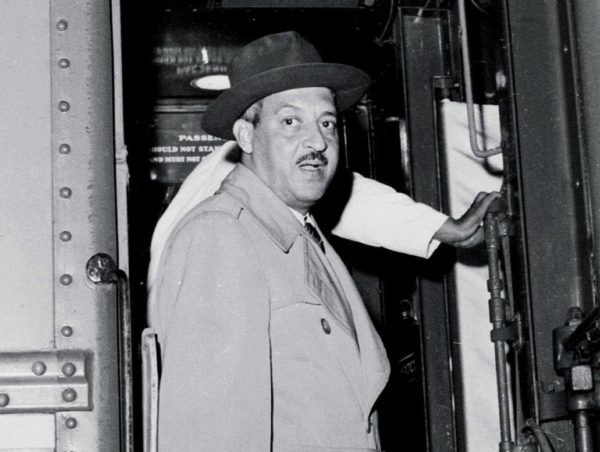It wasn’t long after Cecil Williams was given a camera, at the age 9, that he realized the power and influence of an image — that images conveyed emotions, told stories, impacted viewers and influenced opinions.
Williams focus of exhibit; Arts Center presents ‘A Minimalist in South Carolina’

Attorney Thurgood Marshall is pictured arriving in Charleston to prepare for arguments in the Briggs v. Elliott case. Marshall later became the first African American U.S. Supreme Court justice. Cecil Williams took the photograph when he was 13.
CECIL J. WILLIAMS, SPECIAL TO THE T&D
Whatever he intended his images to convey, Williams wanted the beauty his eye behind the lens perceived to elevate the narrative.
What conveys beauty more eloquently than people posed in their Sunday best or a bride and groom celebrating their wedding day?
“I was earning a dollar or two taking pictures of people visiting Edisto Gardens. At age 11, I photographed my first wedding,” he said.
It wasn’t long after that Williams had a mentor. E.C. Jones, from Sumter, not only encouraged his talent as a photographer, he was the catalyst for changing the course of Williams’ life.
“I accompanied Jones, who was taking pictures of events in Clarendon County. Attending some meetings we covered were the DeLaine and the Pearson families. These families and others from Clarendon County became the Briggs vs. Elliott lawsuit. This was the first legal challenge to school segregation. Later, in Brown vs. Board of Education, Briggs vs. Elliott would become the first of the five arguments included in the historic petition before the Supreme Court,” Williams said.
The justices would rule unanimously that segregation in public schools was, in law, unconstitutional.
“Not many people in South Carolina and beyond know that Briggs vs. Elliott, here in South Carolina, was a key impetous to that Supreme Court decision,” Williams said.
He says these historic petitions weren’t so much an epiphany as an awakening to the power of his lens in the crusade for social justice.
“In the late 50s and early 60s, I saw myself as a chronicler and a photographer when no one was covering South Carolina’s historic movement for civil rights. I was 14 when I started freelancing for Jet magazine. I became their onsite photographer and correspondent reporting on the movement here,” he said.
Williams captured a multitude of images to send to Jet, other prominent African American publications including the Pittsburgh Courier and the Baltimore Afro-American, and eventually the Associated Press. He filed reports of students from Claflin College and South Carolina State College, marching with placards, calling for the end of segregation; the mass incarceration in what is known as the “Pink Palace,” and the most profoundly tumultuous event, the shooting deaths in 1968 of three black young men on the campus of South Carolina State College.
“Photographers, they think of their images as proof they covered an event. When it came to the Orangeburg Massacre, I found myself collecting the spent shell casings. Sometimes something three dimensional brings a deeper meaning and reality to an event a photographer covers,” he said.
Williams says he has over 96,000 images from his seven decades taking pictures, numerous artefacts and historical documents and a collection of architectural drawings.
“When I was a high school student, my dream was to go to Clemson to study architecture. But being born in the era of segregation, that didn’t happen. So, what did I do? I studied architecture on my own. And using my imagination, I created drawings of futuristic houses. One is now my home. The other I’ve transformed into a Civil Rights Museum in order to display my many years of photographs as well as the collections and generous donations which commemorate our unique history and culture in South Carolina,” he said.
Williams’ exhibition at the Orangeburg County Fine Arts Center, “A Minimalist in South Carolina: The Art, Design & Civil Rights Photography of Cecil J. Williams,” encompasses renderings of the weddings and special events he continues to enjoy photographing; his iconic images from South Carolina’s contributions to the Civil Rights Movement and his architectural drawings and unique inventions, including his “Film Toaster,” a device which transforms film to a digitized format. His invention is used around the world.
“A Minimalist in South Carolina: The Art, Design & Civil Rights Photography of Cecil J. Williams” is on view at the Orangeburg County Fine Arts Center, 649 Riverside Drive, until Feb. 29.
The Arts Center is open Monday through Thursday from 9 a.m. to 5 p.m. and on Friday from 9 a.m. to 1 p.m.
For more information, contact vglover@orangeburgarts.org or call 803-536-4074.
Vivian Glover is the Orangeburg County Fine Arts Center Director of Community Arts and Development.



















